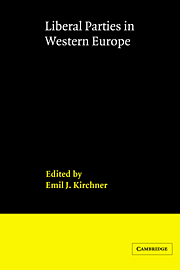Book contents
- Frontmatter
- Contents
- List of tables
- List of diagrams
- List of maps
- Notes on the contributors
- Preface
- 1 Introduction
- 2 Between left and right: the ambivalence of European liberalism
- 3 Two roads of Italian liberalism: the Partito Repubblicano Italiano (PRI) and the Partito Liberale Italiano (PLI)
- 4 The FDP in the Federal Republic of Germany: the requirements of survival and success
- 5 Great Britain — social liberalism reborn?
- 6 Liberalism in France
- 7 Liberal parties in the Netherlands
- 8 The Belgian liberal parties: economic radicals and social conservatives
- 9 The Freiheitliche Partei Österreichs: protest party or governing party?
- 10 The Swedish Liberal Party: The politics of unholy alliances
- 11 Liberalism in Denmark: agrarian, radical and still influential
- 12 The Norwegian Liberal Party: from political pioneer to political footnote
- 13 Liberal parties in Finland: from perennial coalition actors to an extra-parliamentary role
- 14 Liberal parties in Switzerland
- 15 The Luxemburg Liberal Party
- 16 Identifying liberal parties
- 17 Ambivalence revisited: an analysis of liberal party manifestos since 1945
- 18 Transnational links: the ELD and Liberal Party Group in the European Parliament
- 19 Western European liberal parties: developments since 1945 and prospects for the future
- Index of political parties
- General index
2 - Between left and right: the ambivalence of European liberalism
Published online by Cambridge University Press: 16 November 2009
- Frontmatter
- Contents
- List of tables
- List of diagrams
- List of maps
- Notes on the contributors
- Preface
- 1 Introduction
- 2 Between left and right: the ambivalence of European liberalism
- 3 Two roads of Italian liberalism: the Partito Repubblicano Italiano (PRI) and the Partito Liberale Italiano (PLI)
- 4 The FDP in the Federal Republic of Germany: the requirements of survival and success
- 5 Great Britain — social liberalism reborn?
- 6 Liberalism in France
- 7 Liberal parties in the Netherlands
- 8 The Belgian liberal parties: economic radicals and social conservatives
- 9 The Freiheitliche Partei Österreichs: protest party or governing party?
- 10 The Swedish Liberal Party: The politics of unholy alliances
- 11 Liberalism in Denmark: agrarian, radical and still influential
- 12 The Norwegian Liberal Party: from political pioneer to political footnote
- 13 Liberal parties in Finland: from perennial coalition actors to an extra-parliamentary role
- 14 Liberal parties in Switzerland
- 15 The Luxemburg Liberal Party
- 16 Identifying liberal parties
- 17 Ambivalence revisited: an analysis of liberal party manifestos since 1945
- 18 Transnational links: the ELD and Liberal Party Group in the European Parliament
- 19 Western European liberal parties: developments since 1945 and prospects for the future
- Index of political parties
- General index
Summary
the legacy of historical liberalism
Political scientists have some difficulty in dealing with the nature of liberalism and the role played by liberal parties. The problems are not new. In The Rise of European Liberalism, Harold Laski drew attention to the latent conflict between two fundamental liberal principles:
What, then, is the liberalism we have here to discuss? It is not easy to describe, much less to define, for it is hardly less a habit of mind than a body of doctrine. As the latter, no doubt, it is directly related to freedom; for it came as the foe of privilege conferred upon any class in the community by virtue of birth or creed. But the freedom it sought had no title to universality, since its practice was limited to men who had property to defend.
It is not that freedom and property necessarily stand in conflict, but in the context of modern European political development, with the rise of mass democracy, the contradictions became evident, soon to be expressed as property versus freedom.
One consequence is that there is a streak of ambiguity running through European liberalism which is seen in the varied character of liberal parties: some are regarded as belonging to the left, some are more at home on the right, while others hover uneasily between the two. Other political traditions, it is true, also give rise to uncertainties, but not to the same extent. The major families – conservative, Christian democrats, social democrats, and communist – all have a greater ideological coherence.
- Type
- Chapter
- Information
- Liberal Parties in Western Europe , pp. 16 - 28Publisher: Cambridge University PressPrint publication year: 1988
- 17
- Cited by



